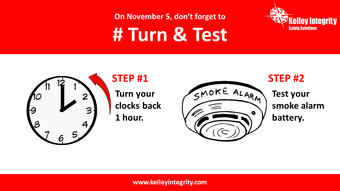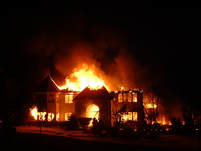 Remember on November 5th, when you set your clock back an hour, test your smoke alarm batteries, also. See, according to the NFPA, or the National Fire Protection Association, between 2009-2013, smoke alarms sounded in more than half (53%) of the home fires reported to U.S. fire departments. Three out of every five home fire deaths resulted from fires in homes with no smoke alarm (38%) or no working smoke alarm (21%).  House Fire House Fire Research shows that 30 years ago, you had about 17 minutes to escape a house fire. Today it’s down to three to four minutes. Sometimes you may have as little as two minutes to get out. The reason: newer homes and the furniture inside them actually burn faster. And a lot faster. In case you've never heard, there's also an old saying, "Close Before you Doze." Closing bedroom doors before going to bed can also help keep extremely toxic smoke from entering the room as you sleep. And may increases the time you have to escape. Having a fire escape plan is another critical element to help protect yourself and your family during a house fire. But simply having a fire escape plan and knowing how to implement it are two separate things. So, once you’ve developed a fire escape plan for your home, it’s important for everyone to practice it. And for children, it can actually be fun to practice and can instill in them the importance of fire safety planning at a young age. Something they may take into adulthood with them.  American Red Cross American Red Cross The American Red Cross has an easy worksheet to help you create your family’s very own fire escape plan. Simply download and print it below and start yours today. Use the graph to draw your home’s floor plan, and plot your home fire escape routes.
Tips for Creating and Practicing Your Escape Plan:
• Everyone in your household should know two ways to escape from each room in your home. • Decide where to meet once you get outside. • If a fire starts, you may have just two minutes to get to safety. So time your fire drills and find out: what’s your escape time? • Smoke is dangerous. Practice low crawling. • Teach household members what to do if their clothes catch fire: stop, drop and roll |
Pat Kelley, CETBoard Certified Environmental, Safety & Health Trainer Categories
All
Archives
January 2019
|
||||||
 Kelley Integrity Safety Solutions, LLC
https://www.kelleyintegrity.com
$$$$
Kelley Integrity Safety Solutions, LLC
https://www.kelleyintegrity.com
$$$$
4709A Hope Rd
82240
Torrington
WY
1-877-736-6438
1-877-736-6438
info@kelleyintegrity.com
 RSS Feed
RSS Feed

